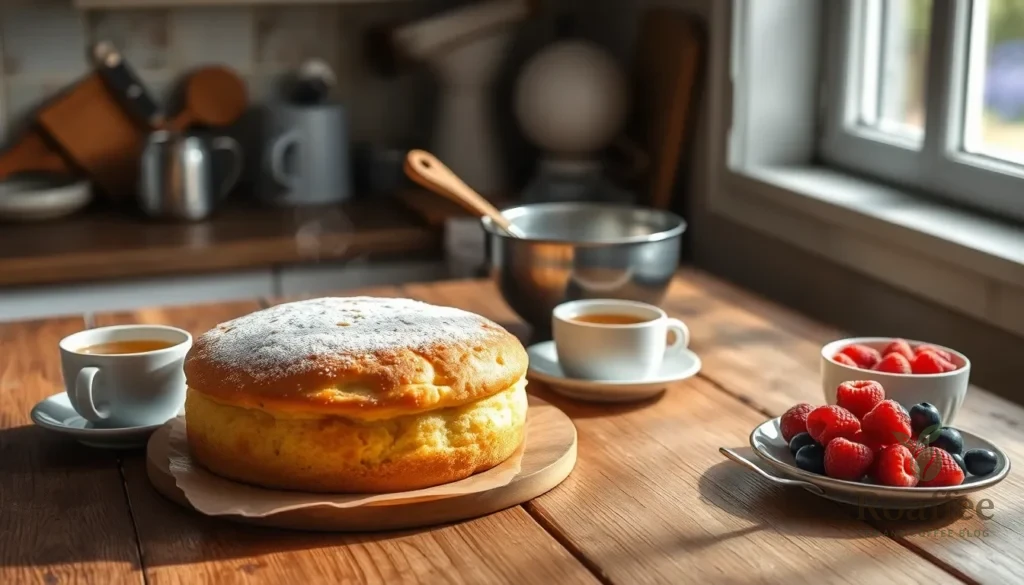There’s something magical about the aroma of a freshly baked tea cake wafting through our kitchen. This classic British treat has been warming hearts and homes for centuries, evolving from simple teatime accompaniments to beloved family favorites that bring people together.
We love how versatile tea cakes can be – whether you’re craving a traditional fruit-studded version or prefer something more modern with chocolate chips or nuts. The beauty lies in their simplicity and the way they pair perfectly with your afternoon cuppa or morning coffee.
What makes our tea cake recipe special is how it delivers that perfect balance of moist crumb and delicate sweetness without being overly complicated. You’ll discover that making homemade tea cakes isn’t just about following a recipe – it’s about creating those cozy moments that make life sweeter.
Ingredients
We’ve carefully selected each ingredient to create the perfect balance of flavors and textures in our tea cake. These simple pantry staples combine to produce a moist tender crumb that pairs beautifully with your favorite hot beverage.
For the Cake
- 2 cups all-purpose flour, sifted
- 1 cup granulated sugar
- 1/2 cup unsalted butter, softened at room temperature
- 2 large eggs, room temperature
- 3/4 cup whole milk, room temperature
- 2 teaspoons baking powder
- 1 teaspoon vanilla extract
- 1/2 teaspoon salt
- 1/2 cup mixed dried fruit (raisins, currants, or sultanas)
- 1/4 cup chopped almonds or walnuts (optional)
For the Glaze
- 1 cup powdered sugar, sifted
- 2 to 3 tablespoons whole milk
- 1/2 teaspoon vanilla extract
- Pinch of salt
Equipment Needed

Creating perfect tea cakes requires the right tools to achieve that ideal texture and shape we’re aiming for. We recommend having a stand mixer like a KitchenAid or a reliable hand mixer on hand for creaming butter and sugar until light and fluffy. This essential step creates the foundation for our tender, moist tea cakes.
Rolling and cutting our dough properly makes all the difference in presentation. We use a small rolling pin to roll the dough evenly to about 1/4 inch thickness. A biscuit cutter or circle cookie cutter works perfectly for shaping our tea cakes into uniform rounds, though a drinking glass can serve as an excellent substitute if needed.
Our baking setup includes standard cookie sheets or baking pans for both chilling the dough and baking the final products. We always keep plastic wrap ready for covering the dough during the chilling process, which helps firm up the mixture for easier handling and cutting.
For those who enjoy adding fresh nutmeg to their tea cakes, we find a microplane grater invaluable for achieving that perfect, aromatic touch. This tool allows us to grate whole nutmeg directly into our mixture, delivering superior flavor compared to pre-ground spices.
| Equipment Category | Essential Tools | Optional Alternatives |
|---|---|---|
| Mixing | Stand mixer (KitchenAid) | Hand mixer |
| Cutting | Biscuit cutter | Circle cookie cutter or drinking glass |
| Rolling | Small rolling pin | Standard rolling pin |
| Baking | Cookie sheets | Baking pans |
| Prep | Plastic wrap | Wax paper |
| Spicing | Microplane grater | Fine grater |
Having these tools properly organized before we begin ensures our tea cake making process flows smoothly from mixing to the final baked result.
Instructions
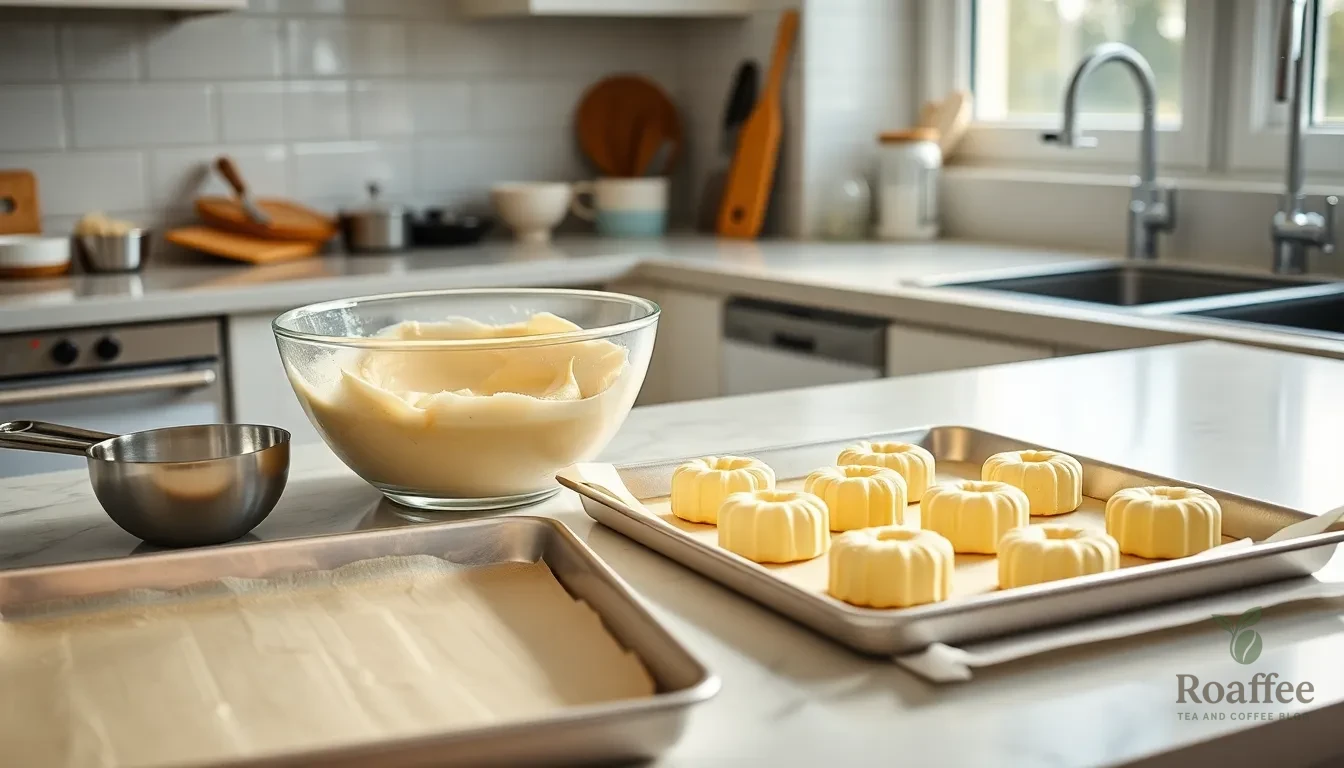
Follow these step-by-step instructions to create perfectly tender tea cakes with a delightful texture and flavor. We’ll guide you through each stage of the baking process for consistent results.
Prep the Pan and Oven
Start by preheating your oven to 375°F. Line two large baking sheets with parchment paper or lightly grease them with butter to prevent sticking. The proper temperature ensures even baking while the prepared surfaces make removal effortless.
Mix the Dry Ingredients
Whisk together 2 cups all-purpose flour, 2 teaspoons baking powder, and 1/2 teaspoon salt in a medium bowl. Add 1/4 teaspoon freshly grated nutmeg if desired for extra warmth. Set this mixture aside until ready to combine with the wet ingredients.
Combine Wet Ingredients
Cream 1/2 cup softened unsalted butter with 3/4 cup granulated sugar using your stand mixer or hand mixer until light and fluffy. Beat in 2 large eggs one at a time, ensuring each egg is fully incorporated before adding the next. Pour in 1/2 cup whole milk and 1 teaspoon vanilla extract, mixing until smooth.
Make the Batter
Gradually add the dry ingredient mixture to the wet ingredients, mixing on low speed until just combined. Avoid overmixing as this can result in tough tea cakes. Fold in 1/2 cup mixed dried fruit and 1/4 cup chopped nuts if using, distributing them evenly throughout the batter.
Bake the Tea Cake
Drop rounded tablespoons of batter onto the prepared baking sheets, spacing them about 2 inches apart. Bake for 12-15 minutes until the edges are lightly golden and the centers spring back when gently touched. Transfer the tea cakes to wire racks and let them cool completely before applying the optional glaze.
Make-Ahead Instructions
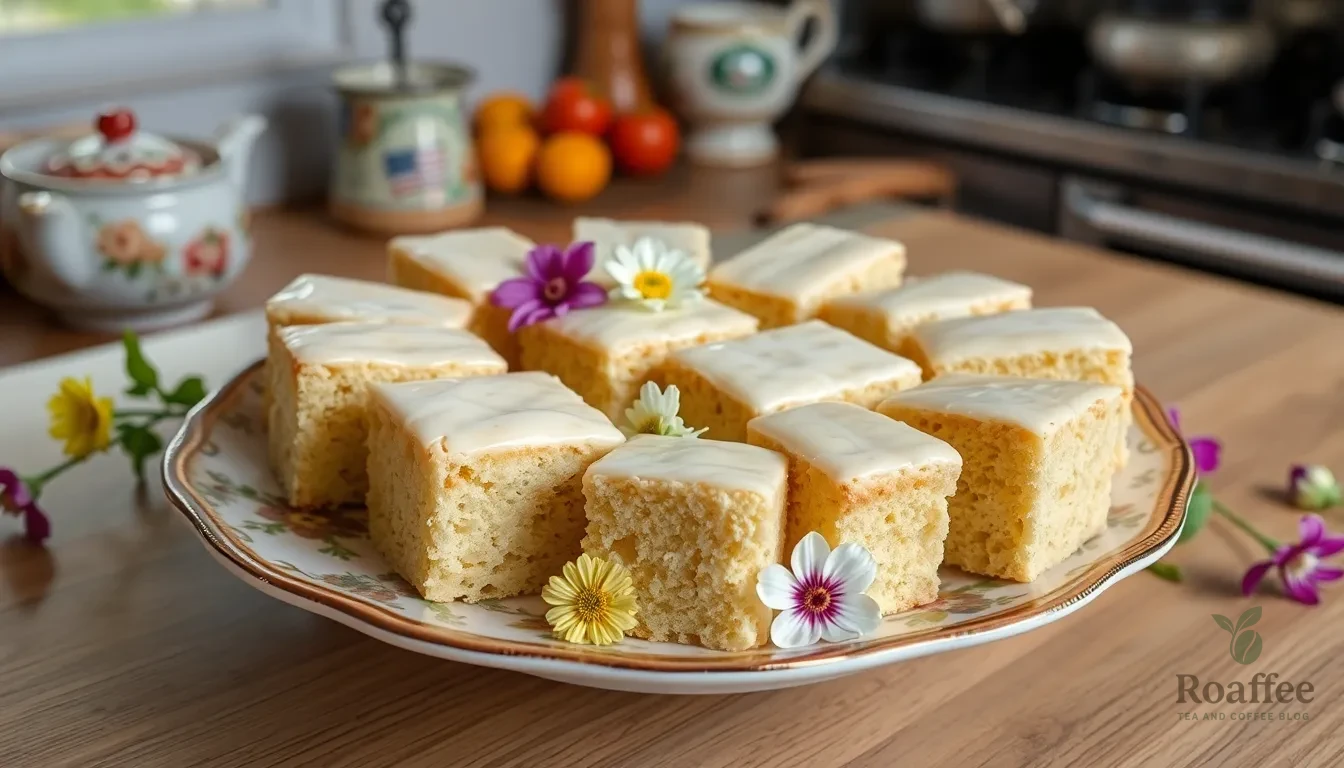
We love how easy it is to prepare tea cakes ahead of time for convenient baking later. The beauty of this recipe lies in its flexibility for advance preparation.
Dough Storage Options:
| Storage Method | Duration | Storage Details |
|---|---|---|
| Refrigerator | 2 hours to 3 days | Wrap dough disk in plastic wrap |
| Freezer | Up to 3 months | Double wrap in plastic wrap and foil |
| Cut cookies (pre-baking) | 24 hours | Chill on baking sheets covered |
Preparing Dough in Advance:
After mixing our dough we shape it into a disk and wrap it tightly in plastic wrap. The dough actually benefits from chilling time as it allows the flour to fully hydrate and makes rolling much easier. We recommend chilling for at least 2 hours before rolling and cutting.
For longer storage we can refrigerate the wrapped dough for up to 3 days. The dough becomes firmer with extended chilling which helps maintain better shape during baking.
Freezing Dough:
We can freeze the dough disk for up to 3 months by double wrapping it in plastic wrap then aluminum foil. When ready to bake we thaw the dough in the refrigerator overnight before rolling and cutting.
Pre-Cut Cookie Storage:
After cutting our tea cakes we can arrange them on baking sheets and chill for up to 24 hours before baking. This chilling step actually reduces spreading during baking and helps maintain cleaner edges and better shape.
Storing Baked Tea Cakes:
Freshly baked tea cakes stay fresh in airtight containers for up to 5 days at room temperature. We store them in single layers separated by parchment paper to prevent sticking. The glaze should be completely set before storing to avoid mess.
These make ahead options ensure we can enjoy fresh tea cakes whenever the craving strikes without the full preparation time.
Storage Tips

Proper storage ensures our tea cakes maintain their delightful texture and flavor for days or even months. We’ve compiled essential guidelines for keeping your baked treats fresh whether you plan to enjoy them immediately or save them for later.
Room Temperature Storage
Store freshly baked tea cakes in airtight containers at room temperature for optimal freshness. Most tea cake varieties maintain their quality for 3 to 5 days when properly sealed. Southern tea cakes stay fresh for approximately 3 days while Russian tea cakes hold their texture for up to 4 days in sealed containers.
| Tea Cake Type | Room Temperature Storage | Container Type |
|---|---|---|
| Southern Tea Cakes | 3 days | Airtight container |
| Russian Tea Cakes | 4 days | Airtight container |
| Irish Tea Cake | 3 days | Covered container |
Refrigerated Storage
Refrigeration extends the freshness of certain tea cake varieties beyond room temperature limits. Southern style tea cakes benefit from refrigerated storage and remain fresh for up to one week when kept in airtight containers. Cold storage particularly helps maintain moisture in cakes with glazes or icings.
Freezing for Long Term Storage
Freeze tea cakes for extended preservation ranging from 3 to 6 months depending on the variety. Wrap finished cakes tightly in freezer safe containers or use a combination of foil and plastic wrap for maximum protection. Southern tea cake dough freezes exceptionally well for up to 6 months whether shaped into individual portions or formed into logs.
Russian tea cakes freeze successfully for up to 2 months while Irish tea cakes maintain quality for 3 months when properly wrapped. Dough can be frozen either pre shaped or in bulk form for convenient future baking.
Thawing Guidelines
Thaw frozen tea cakes at room temperature or transfer them to the refrigerator for gradual defrosting. Frozen dough requires refrigerator thawing before baking to ensure even cooking. Russian tea cakes benefit from recoating with powdered sugar after thawing to refresh their distinctive appearance and texture.
Allow adequate thawing time for larger batches and avoid rushing the process with heat sources that could compromise texture. Room temperature thawing typically takes 1 to 2 hours for individual cakes while bulk quantities may require longer periods.
Serving Suggestions
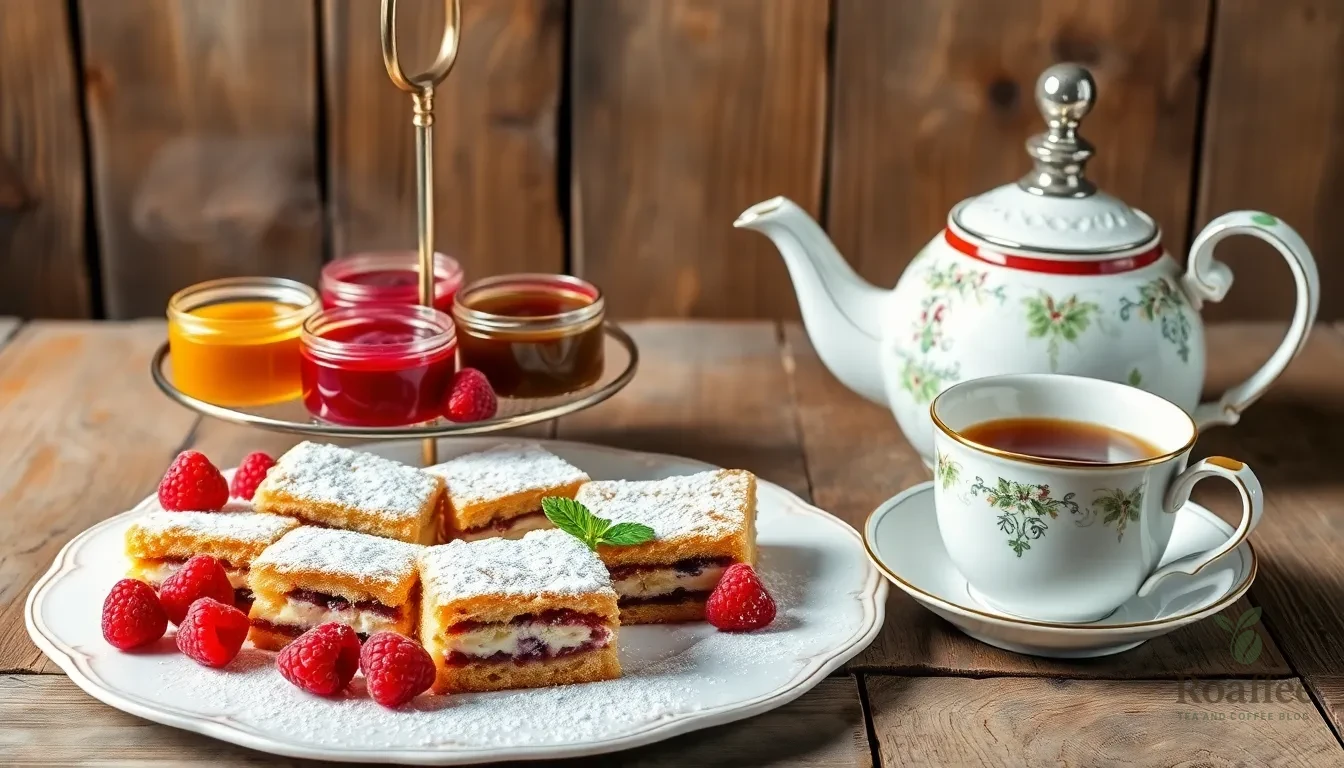
We love presenting our tea cakes in ways that showcase their versatility and enhance the overall experience. Traditional Irish tea cakes shine brightest when served with fresh berries like raspberries and a light dusting of powdered sugar, creating a beautiful contrast of colors and flavors that pairs perfectly with afternoon tea.
Southern style tea cakes offer incredible flexibility for presentation. We recommend serving them alongside vanilla ice cream for a delightful temperature contrast, or pairing them with mixed fresh fruit for a lighter option. Fruit jams and preserves work wonderfully as accompaniments, allowing guests to customize their experience with flavors like strawberry, peach, or apricot.
English tea cakes carry their own serving tradition that we absolutely adore. These treats taste best when served warm from the oven, split open and generously buttered. Modern serving approaches include toasting them lightly and spreading with butter, which creates a delicious golden exterior while maintaining the soft interior texture.
Temperature plays a crucial role in serving tea cakes effectively. We find that slightly warm tea cakes release their aromas more readily and provide a comforting experience, especially during cooler weather. Room temperature serving works beautifully for outdoor gatherings or summer occasions.
Beverage pairings enhance the tea cake experience significantly. Classic black tea remains the traditional choice, but we also love serving them with Earl Grey, English Breakfast, or even coffee for those who prefer a stronger flavor profile. Hot chocolate creates an indulgent pairing that children particularly enjoy.
Creative presentation options include arranging tea cakes on tiered serving stands for elegant afternoon tea settings, or placing them in rustic baskets lined with linen napkins for casual gatherings. We often garnish the serving plate with fresh mint leaves or edible flowers to add visual appeal and a subtle aromatic touch.
Variations
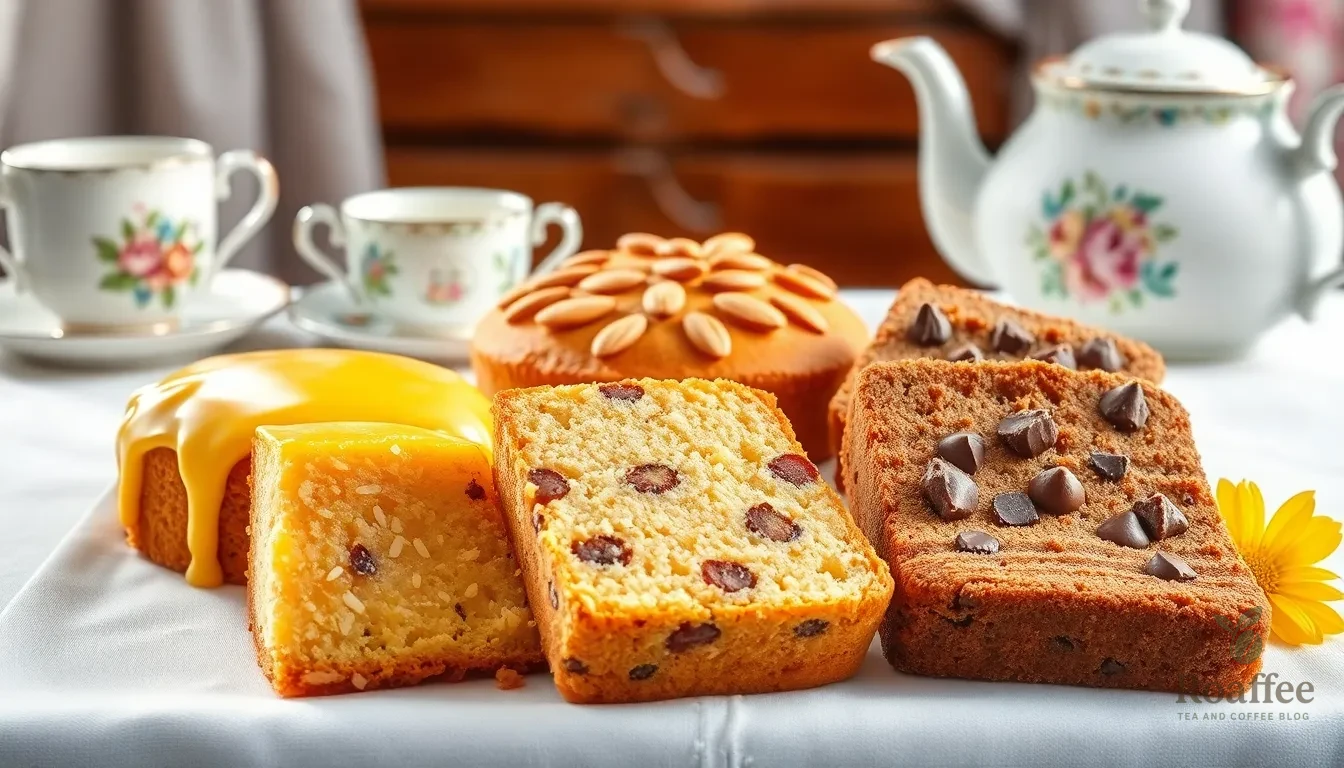
Tea cakes offer endless possibilities for customization, allowing us to create distinct flavors that complement different occasions and preferences. These popular variations showcase how simple ingredient swaps can transform our basic tea cake recipe into exciting new treats.
Lemon Tea Cake
Lemon tea cakes bring bright citrus notes that perfectly complement the tender crumb of our traditional recipe. We achieve this vibrant flavor by incorporating fresh lemon zest and juice into the batter, creating a cake that’s both fragrant and refreshing. The addition of orange zest adds complexity to the citrus profile, while a touch of almond paste enhances the overall richness.
For the best results, we recommend using the zest from two lemons and adding two tablespoons of fresh lemon juice to replace part of the milk in our base recipe. A simple lemon glaze made from powdered sugar and lemon juice creates the perfect finishing touch that intensifies the citrus flavor.
Almond Tea Cake
Almond tea cakes deliver a sophisticated nutty flavor that pairs beautifully with afternoon tea. We create this variation by incorporating almond paste or almond extract into our batter, which provides a rich, marzipan-like taste that elevates the entire cake. Sliced almonds sprinkled on top before baking add textural interest and visual appeal.
Our Italian-style approach combines almond extract with a hint of lemon zest for balance, creating a cake that’s both aromatic and flavorful. We often top these cakes with a light almond crumble made from butter, flour, and sliced almonds, which adds an extra layer of texture and intensifies the nutty flavor profile.
Chocolate Chip Tea Cake
Chocolate chip tea cakes transform our classic recipe into a more indulgent treat that appeals to chocolate lovers of all ages. We fold chocolate chunks or chips into the dough along with a pinch of warm cardamom, which adds an unexpected spice note that complements the chocolate beautifully. This variation often uses a yeast-leavened dough for a softer, more bun-like texture.
The key to success lies in using high-quality chocolate chunks rather than standard chips, as they create pockets of rich chocolate throughout each bite. We finish these cakes with a light egg wash before baking and a simple confectioner’s sugar frosting afterward, creating a bakery-style treat that’s perfect for special occasions.
Troubleshooting Tips

Even experienced bakers encounter challenges when making tea cakes. We’ve compiled the most common issues and their answers to ensure your tea cakes turn out perfectly every time.
Dense or Heavy Tea Cakes
Dense tea cakes typically result from butter that isn’t at room temperature or overmixing the batter. We recommend taking your butter out of the refrigerator 30 to 60 minutes before baking to achieve the proper consistency. When creaming butter and sugar together, the mixture should become light and fluffy before adding other ingredients. Stop mixing as soon as the flour disappears into the batter to prevent developing too much gluten.
Cracked Tops on Baked Tea Cakes
Oven temperatures running too high often cause cracked tops on tea cakes. We suggest using an oven thermometer to verify your oven’s actual temperature matches the setting. Also, using the wrong pan size can contribute to cracking. Ensure you’re using the recommended pan dimensions from your recipe for even heat distribution.
Tea Cakes Spreading Too Much
Dough that spreads excessively during baking needs to be chilled before going into the oven. We recommend rolling your dough to at least 1/4 inch thickness to maintain a soft interior while preventing excessive spreading. Keep the shaped dough cold by refrigerating it for 15 to 30 minutes before baking. Use parchment or waxed paper sprinkled with flour when rolling to make handling easier.
Removing Tea Cakes from Pans
Proper cooling prevents tea cakes from breaking when removing them from pans. We always cool our tea cakes on a wire rack to allow air circulation underneath. This prevents condensation from forming on the bottom and making the cakes soggy. Wait until the cakes reach room temperature before attempting to remove them from their pans.
Excess Moisture in Add-ins
Wet ingredients like fresh berries or chopped fruit can make tea cake batter too moist. We use a fine mesh strainer to remove excess liquid from fruits and vegetables before folding them into the batter. Adding a pinch of salt to watery ingredients helps draw out moisture naturally. Pat dried fruits with paper towels to remove surface moisture before incorporating them into your recipe.
Achieving Proper Texture
Room temperature ingredients blend more easily and create better texture in tea cakes. We bring eggs and milk to room temperature by placing them in warm water for 10 to 15 minutes before use. This ensures smooth incorporation and prevents the butter from seizing when cold ingredients are added. Proper ingredient temperatures contribute significantly to the final tender crumb structure.
Conclusion
We’ve shared everything you need to create delicious homemade tea cakes that’ll become a treasured part of your baking repertoire. From mastering the basic recipe to exploring creative variations these treats offer endless possibilities for customization and enjoyment.
Whether you’re planning ahead with make-ahead tips or troubleshooting common baking challenges our comprehensive guide ensures success every time. The beauty of tea cakes lies in their simplicity and versatility making them perfect for any occasion.
Now it’s time to gather your ingredients preheat that oven and start baking. We’re confident you’ll love how these tender flavorful tea cakes bring warmth and joy to your kitchen and create those special moments that make homemade treats so memorable.
Frequently Asked Questions
What are tea cakes and where do they come from?
Tea cakes are classic British treats that have evolved into beloved family favorites. They’re versatile baked goods that can range from traditional fruit-studded varieties to modern versions with chocolate chips or nuts. Originally from Britain, these delightful cakes are perfect for pairing with tea or coffee and have become popular worldwide.
What ingredients do I need to make tea cakes?
Essential ingredients include all-purpose flour, granulated sugar, unsalted butter, eggs, whole milk, baking powder, vanilla extract, and salt. Optional add-ins are mixed dried fruit and nuts. For the glaze, you’ll need powdered sugar, milk, vanilla extract, and a pinch of salt. These pantry staples create the perfect balance of flavors and textures.
What equipment is necessary for making tea cakes?
Key tools include a stand mixer or hand mixer for creaming butter and sugar, a small rolling pin for rolling dough, and a biscuit cutter or drinking glass for shaping. You’ll also need cookie sheets or baking pans, plastic wrap for chilling dough, and optionally a microplane grater for fresh nutmeg. Proper organization ensures smooth baking.
How do I bake tea cakes step by step?
Preheat your oven to 375°F and prepare baking sheets. Mix dry ingredients separately, then combine wet ingredients. Create the batter by combining both mixtures, being careful not to overmix. Drop batter onto prepared sheets and bake according to recipe timing. The key is gentle mixing and proper temperature control for tender results.
Can I make tea cake dough ahead of time?
Yes! Tea cake dough can be refrigerated for up to 3 days or frozen for up to 3 months. Chilling actually enhances the dough’s texture and makes it easier to handle. Pre-cut cookies can be chilled for up to 24 hours before baking to maintain their shape, making preparation very convenient.
How should I store baked tea cakes?
Store freshly baked tea cakes in airtight containers at room temperature for 3-5 days. Refrigeration can extend freshness up to a week, especially for Southern tea cakes. For long-term storage, freeze tea cakes for 3-6 months. Always ensure proper wrapping to maintain texture and follow specific thawing guidelines when needed.
What are the best ways to serve tea cakes?
Traditional Irish tea cakes pair beautifully with fresh berries and powdered sugar. Southern style tea cakes complement vanilla ice cream or fruit jams. English tea cakes are best served warm, buttered, or toasted. Consider beverage pairings like black tea, Earl Grey, or coffee, and adjust presentation for different occasions.
What tea cake variations can I try?
Popular variations include lemon tea cakes with fresh zest and juice for brightness, almond tea cakes featuring almond paste for nuttiness, and chocolate chip tea cakes with chocolate chunks and cardamom for indulgence. Simple ingredient swaps create distinct flavors while maintaining the classic tea cake foundation, perfect for different preferences and occasions.
How do I troubleshoot common tea cake baking problems?
For dense cakes, ensure butter is at room temperature and don’t overmix. Prevent cracked tops by using correct pan sizes and oven temperature. Stop excessive spreading by chilling dough before baking. Always cool cakes on wire racks for proper texture. Using room temperature ingredients and managing moisture from add-ins helps achieve perfect results.

